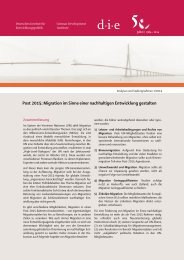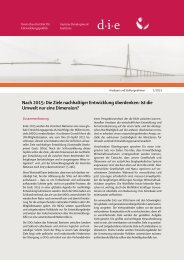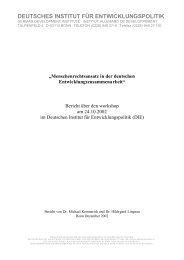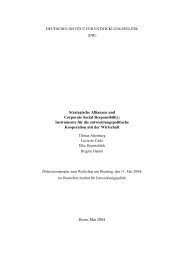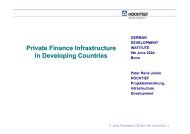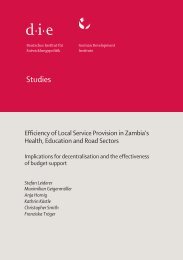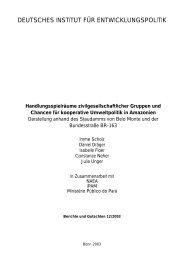Middle East / North Africa and the Millennium Development Goals ...
Middle East / North Africa and the Millennium Development Goals ...
Middle East / North Africa and the Millennium Development Goals ...
You also want an ePaper? Increase the reach of your titles
YUMPU automatically turns print PDFs into web optimized ePapers that Google loves.
<strong>Middle</strong> <strong>East</strong> / <strong>North</strong> <strong>Africa</strong> <strong>and</strong> <strong>the</strong> <strong>Millennium</strong> <strong>Development</strong> <strong>Goals</strong><br />
meant primarily for <strong>the</strong> eyes of donors. In o<strong>the</strong>r words, <strong>the</strong>y contain what<br />
<strong>the</strong> donors are interested in reading.<br />
Ano<strong>the</strong>r typical development is that in 2004, four years after <strong>the</strong> <strong>Millennium</strong><br />
Summit, <strong>the</strong> Egyptian government, toge<strong>the</strong>r with <strong>the</strong> World Bank,<br />
presented a poverty reduction strategy which, in <strong>the</strong> 53 pages of which it<br />
consists, not once mentions <strong>the</strong> MDGs <strong>and</strong> continues to view poverty<br />
merely as income poverty. The nonmonetary aspects of poverty (lack of<br />
education, health, participation, etc.) are not even addressed in <strong>the</strong> paper<br />
(Egypt / World Bank 2004).<br />
Much <strong>the</strong> same can be said of a World Bank Poverty Report on Morocco<br />
(World Bank 2004g) which mentions <strong>the</strong> MDGs only in a footnote, likewise<br />
equating poverty with income poverty.<br />
The second group of countries includes Yemen in <strong>the</strong> <strong>Middle</strong> <strong>East</strong> <strong>and</strong> Algeria<br />
<strong>and</strong> Mauritania in <strong>North</strong> <strong>Africa</strong>. It is certainly not by chance that two<br />
of <strong>the</strong>se countries are low-income countries <strong>and</strong> that <strong>the</strong>y have prepared<br />
PRSPs. All three countries are typified by a public discourse that is quite<br />
transparent by regional comparison, <strong>and</strong> all three are – though for different<br />
reasons – highly dependent on <strong>the</strong> benevolence of donors.<br />
The countries of <strong>the</strong> second group have explicitly translated all of <strong>the</strong><br />
MDGs into national development goals. They fur<strong>the</strong>rmore differ from <strong>the</strong><br />
countries of <strong>the</strong> first group in that <strong>the</strong>y engage in far more self-criticism. In<br />
official communiqués <strong>and</strong> documents <strong>the</strong> governments of <strong>the</strong>se countries<br />
state relatively frankly what strategic errors <strong>and</strong> omissions <strong>the</strong>y have made<br />
in <strong>the</strong> past <strong>and</strong> what major policy changes <strong>the</strong>y see as necessary. Their<br />
strategy papers contain long lists of highly precise <strong>and</strong> very ambitious<br />
goals, which also include <strong>the</strong> MDGs.<br />
One particularly typical case here is Mauritania, which presented a PRSP as<br />
early as 2001. All of <strong>the</strong> MDGs are addressed in it, although <strong>the</strong> PRSP in<br />
some cases goes far beyond <strong>the</strong> targets set out under <strong>the</strong> MDG agenda. To<br />
cite an example, under <strong>the</strong> PRSP, <strong>the</strong> proportion of income-poor as a percentage<br />
of <strong>the</strong> population is set to be reduced from 57 % in 1990 to 19 % by<br />
2015 – <strong>and</strong> not ‘only’ to 28 %, as targeted in MDG1. Fur<strong>the</strong>rmore, <strong>the</strong> PRSP<br />
provides for an upper limit of 1 % of <strong>the</strong> overall population for <strong>the</strong> country’s<br />
HIV prevalence rate. And ano<strong>the</strong>r of its PRSP goals is to lower <strong>the</strong> illiteracy<br />
rate to 0 % by 2015 – an objective that appears highly unrealistic in view of<br />
today’s illiteracy rate of nearly 60 % (UNDG 2002).<br />
German <strong>Development</strong> Institute 115



